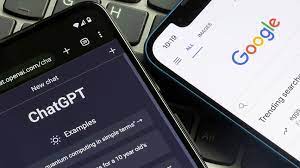ChatGPT vs. Google

February 10, 2023
By now, everyone has heard of the supernatural AI system, known as ChatGPT. With a few simple directions, sentences, and phrases, a thesis or essay is created in seconds. The real question that everyone keeps wondering is where this technology will take society and how it is going to affect future creations and current problems.
ChatGPT, also known as a chat generative pre-trained transformer, was launched by OpenAI in November 2022. The goal was to help simplify mass information and construct a better system to organize information in a clear way. ChatGPT started as an approach to transfer learning, with supervised and reinforcement learning techniques. Originated from GPT-3, ChatGPT is a significant improvement, but is still a part of the large language model. The large language model is capable of generating text in a wide range of styles and for different subjects. However, with ChatGPT, there is greater precision, detail, and coherence, with a stronger focus on interactive conversations. ChatGPT is so interactive because it was created with the intention of using human feedback in a training loop, which minimizes harmful, untruthful, or biased information. ChatGPT is unlike any other AI due to its Supervised Learning and Reinforcement Learning enhancements.
Now where Microsoft is continuing to expand, Google is being left behind. In an attempt to keep up with ChatGPT and make sure that Google still has users, a new chat box has been created called “Bard”. Bard is a conversational service aimed at countering ChatGPT. Sundar Pichai, the CEO of Google, states that, “Bard can be an outlet for creativity, and a launchpad for curiosity.” In the first couple weeks, Bard will only be touched by professional testers, but will eventually be opened up to the public. Bard will be able to explain complex subjects in simple terms and even provide mundane tasks, such as giving tips or ideas for parties or dinners. Named after the famous playwright, William Shakespeare, Bard will eventually be able to live up to its name, by creating well thought out and exceptionally written essays.
While both companies are racing against the clock to produce a self-functioning AI, Microsoft has been pouring billions of dollars into ChatGPT, putting pressure on Google to keep up with the ever-changing field of technology. Google has even initiated a ‘code red’, ensuring that Google engineers make Bard their first priority. Currently, 10 million users have switched over to using ChatGPT. However, Google plans on incorporating a Language Model for Dialogue Applications(LaMDA) into Google’s search in the near future, which will provide vast knowledge to the billions of questions asked every day. The LaMDA is the system in which Bard is currently attached to.
In a larger commitment, Google is partnering with Anthropic, an AI start-up led by former AI leaders. With the use of their chatbot, Claude, their mission is to ensure AI safety. With multiple test-runs, the chat boxes were trained on vast masses of data online to generate compelling responses to prompts. Their goal is to combine world knowledge with power, intelligence, and creativity. Microsoft also hopes to commit ChatGPT to serve under Bing, which would turn into major profits for Microsoft.
However, with advances are always setbacks, and Google worries that with the loss of viewers having switched from Google to ChatGPT, Google may only be a few years away from disruption. Another worry is that if Bard is not incorporated into a search engine soon, without access to online data, experts believe that Bard will begin to spread false information over the internet.
With billions of dollars invested into ChatGPT and being signed onto Bing, this past Tuesday, February 7, ChatGPT is not going anywhere. However, the question still remains if Google will make a comeback with Bard, or if it will crash, leaving many without access to a search engine.
Underneath is an example of what ChatGPT is capable of. All that was typed into the search section was “ChatGPT versus Google” and “ChatGPT versus Bard” and a passage was created. This shows just how little information needs to be put in the search bar in order to receive a generated response.
“ChatGPT and Google are two different entities with different functions and capabilities.
Google is a multinational technology company that specializes in Internet-related services and products, such as search engines, online advertising technologies, cloud computing, software, and hardware.
ChatGPT, on the other hand, is an AI-powered language model developed by OpenAI. It is trained on a large corpus of text data to generate human-like text in response to prompts. It can be used for various natural language processing tasks, such as answering questions, generating text, and more.
In essence, Google is a technology company that offers a variety of products and services, while ChatGPT is a specific AI model developed for language processing tasks.
GPT-3 (ChatGPT) and GPT-2 (Bard) are both language models developed by OpenAI. They are part of the Generative Pre-trained Transformer (GPT) series of models, which are trained on a large corpus of text data using deep learning techniques.
However, there are some differences between the two models.
GPT-3 (ChatGPT) is the latest and largest version of the GPT series of models, with 175 billion parameters. It is trained on an even larger corpus of text data than its predecessors, resulting in improved accuracy and fluency in language generation tasks.
GPT-2 (Bard), on the other hand, has 1.5 billion parameters and was trained on a smaller corpus of text data. While it is still capable of generating human-like text, it may not be as accurate or fluent as GPT-3 (ChatGPT).”
Overall, both models have their own strengths and weaknesses, but GPT-3 (ChatGPT) is generally considered to be the more advanced and capable language model.


